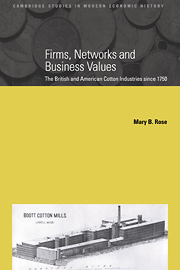Book contents
- Frontmatter
- Contents
- List of figures
- List of tables
- Acknowledgements
- 1 Introduction: the evolution of two industries
- Part I The culture of business networks 1750–1860
- Part II Continuity and change
- 6 Consolidation and change, 1860–1914
- 7 Prosperity and decay in war and peace, 1914–39
- 8 The turbulent years, 1939–80: the politics of decline
- 9 Conclusion
- References
- Index
- Cambridge Studies in Modern Economic History
8 - The turbulent years, 1939–80: the politics of decline
Published online by Cambridge University Press: 12 September 2009
- Frontmatter
- Contents
- List of figures
- List of tables
- Acknowledgements
- 1 Introduction: the evolution of two industries
- Part I The culture of business networks 1750–1860
- Part II Continuity and change
- 6 Consolidation and change, 1860–1914
- 7 Prosperity and decay in war and peace, 1914–39
- 8 The turbulent years, 1939–80: the politics of decline
- 9 Conclusion
- References
- Index
- Cambridge Studies in Modern Economic History
Summary
Two decades of difficulty for the British and American cotton industries were followed by the outbreak of the Second World War, which did nothing to balk the trend of Lancashire's collapse or the shift of the United States cotton industry from North to South. The Lancashire cotton industry became far more automated in the 1960s, with the scrapping of redundant machinery, yet this did little to halt the inexorable decline of the industry. Accordingly, in the next 20 years Lancashire's demise was virtually complete, as Table 8.1 shows, with almost the last vestiges of a dying industry vanishing in the 1981 recession. In the United States, between 1950 and 1970, 300,000 textile jobs were lost in New England alone, whilst an increasingly capital-intensive industry, which was based upon multi-fibres, continued to develop in the South. In the 1970s and early 1980s, however, unemployment in the Southern states began to rise at an alarming rate and numerous businesses closed or were taken over (Gaventa and Smith 1991: 182). Nevertheless the cotton and related industries survived, albeit on a diminished scale and, by 1983, the United States had the distinction of being home to the world's most ‘productive’ textile industry.
The shifting role of business communities has been inseparable from the evolution of cotton manufacturing from the eighteenth century. Similarly, in the second half of the twentieth century the decay of communities based upon cotton and the demise of industrial districts, deprived of their dynamism, is a reflection of the collapse of the industry.
- Type
- Chapter
- Information
- Firms, Networks and Business ValuesThe British and American Cotton Industries since 1750, pp. 250 - 295Publisher: Cambridge University PressPrint publication year: 2000



